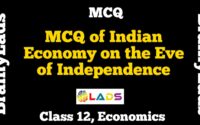MCQ of Human Capital Formation | Class 12 | Economics | Part B |
MCQ of Human Capital Formation | Class 12 | Economics | Part B |
Q1. Human capital refers to the stock of ____ of a nation at a point of time
a. Exports items
b. Imports items
c. Skill and expertise
d. None of these
Answer: Skill and expertise
Q2. ____ is the process of acquiring and increasing the number of persons who have the skill, education and experience which are essential for the economic and political development of a country.
a. Human capital formation
b. Physical capital formation
c. Financial capital formation
d. Both a and b
Answer : Human capital formation
Q3. Sources of human capital formation involve
a. Expenditure on education
b. Expenditure on health
c. Migration
d. All of these
Answer: All of these
Q4. ____ is known as the ability to read and write.
a. Education
b. Human capital
c. Literacy
d. Human development
Answer: Literacy
Q5. As per census 2011, the literacy rate in rural India is about
a. 72%
b. 45%
c. 69%
d. 56%
Answer: 69%
Q6. What is the percentage of Female literacy in India?
a. 66%
b. 81%
c. 89%
d. 70%
Answer : 66%
Q7. Migration of skilled manpower to developed countries of the world is known as
a. Migration
b. Human capital
c. Brain drain
d. Decentralization
Answer : Brain drain
Q8. Merit of human capital formation includes
a. Improves technical knowledge
b. Enlarges the size of business
c. Increases cost of production
d. Changes social outlooks
Answer: Increases cost of production
Q9. ____ is not an indicator of education level?
a. Years of schooling
b. Life expectancy
c. Teacher-pupil ratio
d. Enrollment rate
Answer: Life expectancy
Q10. Expenditure per student in _______ education is higher than that of elementary.
a. Secondary
b. Primary
c. Tertiary
d. None of these
Answer : Tertiary
We would love to see you going through MCQ of Indian Economy on the Eve of Independence, MCQ of Indian Reforms Since 1991, MCQ of Rural Development, MCQ of Poverty for better clarity and understanding of the chapters.
Q11. _______ is the prime funding authority for university education.
a. LPG
b. UGL
c. UPSC
d. UGC
Answer: UGC
Q12. India has the potential to become a leading _______ economy.
a. Capital based
b. Youth based
c. Knowledge-based
d. All of these
Answer: Knowledge-based
Q13. Higher-income causes building of high level of ________ capital.
a. Physical
b. Human
c. Financial
d. None of these
Answer: Human
Q14. Human capital considers education and health as a means to increase _________
a. Publicity
b. Population
c. Private powers
d. Productivity
Answer: Productivity
Q15. Economic growth means ________ in real national income of a country
a. Increase
b. Decrease
c. No change
d. Zero
Answer: Increase
Q16. ________ capital is completely mobile between countries.
a. Physical
b. Human
c. Financial
d. None of these
Answer: Physical
Q17. _______ is the reason for the rural-urban migration in India.
a. Over population
b. Unemployment
c. Higher infant mortality rate
d. Childhood marriages
Answer : Unemployment
Q18. Individuals invest in education with the objective of increasing their future ________
a. Friends
b. Income
c. Family
d. All of these
Answer: Income
Q19. Human capital formation is a _______ process.
a. Physical
b. Social
c. Chemical
d. Long
Answer: Social
Q20. Role of on-the-job training doesn’t include
a. Eradicates inequality
b. Encourages innovation
c. Promotes modern methods
d. Enhances productivity
Answer: Enhances productivity
Q21. What was the average youth literacy rate in 2015?
a. 89.5 percent
b. 74 percent
c. 88 percent
d. 95.5 percent
Answer : 89.5 percent
Q22. In which year Right to Education Act was enacted?
a. 2008
b. 2009
c. 2010
d. 2012
Answer : 2009
Q23. What percent of GDP was invested in education in the year 1952?
a. 7.92 percent
b. 11.7 percent
c. 0.64 percent
d. 3.31 percent
Answer : 0.64 percent
Q24. What was the share of education in total government expenditure in 2014?
a. 7.92 percent
b. 15.7 percent
c. 0.64 percent
d. 3.31 percent
Answer: 15.7 percent
Q25. Which level of education takes a major share of total education expenditure in India?
a. Elementary
b. Secondary
c. Higher
d. Tertiary
Answer :Elementary
Q26. Which of the following institute comes under the health sector?
a. NCERT
b. UGC
c. AICTE
d. ICMR
Answer: ICMR
Q27. _____ five year plan recognizes the importance of human capital?
a. Seventh
b. Sixth
c. Tenth
d. First
Answer: Seventh
Q28. ______ capital is tangible and can be sold in the Market
a. Human
b. Physical
c. Service
d. None of these
Answer: Physical
Q29. _____ organisation enforces the rules and regulations regarding technical education
a. NCERT
b. AICTE
c. ICMR
d. UGC
Answer: AICTE
Q30. Institutions providing elementary education have increased up to ______ times
a. Four
b. Five
c. Six
d. Seven
Answer: Five
Do share this post if you liked the MCQ of Human Capital Formation. For more updates, keep logging on BrainyLads


